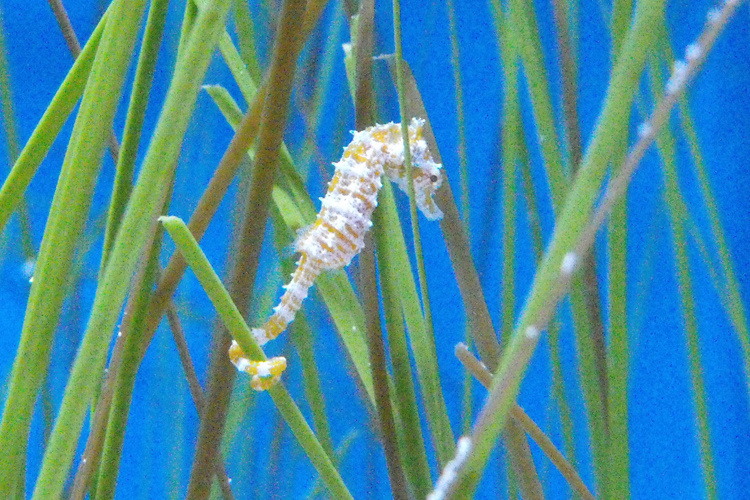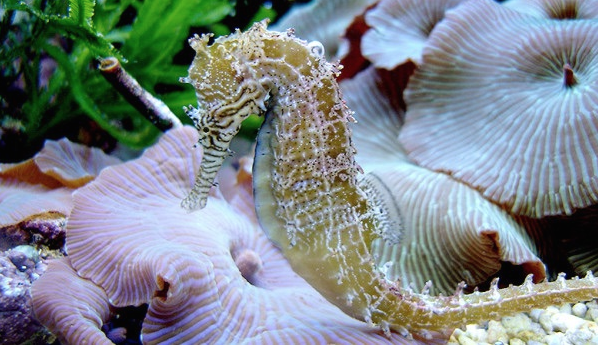Seahorses are one of the coolest creatures on this planet – period. I mean who doesn’t like seahorses? People state “I love snakes”, “I hate snakes”, “I love sharks”, “I hate sharks”. But no one says, “I hate seahorses”. They are sort of in the same boat with sea turtles, everyone loves sea turtles. They are an icon of the sea, logos for beach products and coastal HOAs, underwater cartoons and tourist development boards, diving clubs and local restaurants. But have you ever seen one? I mean beyond seeing one at a local aquarium or such, have you ever found one while snorkeling on one of our beaches?
Most would say no.
I have lived in the panhandle all my life and have spent much of it in the water, and I can count on both hands the number of times I have encountered a seahorse while at the beach. Most encounters have been while seining. I cannot count on both hands how many times I have pulled a seine net here but very few of them did a seahorse encounter occur. When they did, it was over grassbeds. In each encounter the animal was lying in the grass not wriggling like the other fish, just lying there. It would be very easy to miss them discarding it as “grass”. It makes you wonder how many times I captured one and did not know it. When we did find one it was VERY exciting. My students would often scream “I had NO idea they lived here!”.
However, if you tried searching for them while snorkeling, which I have, the encounter rate is zero. But this makes sense. These animals are so well camouflaged in the grass it would be a miracle to find one just hanging there. This is by necessity really. If you have ever watched a seahorse in an aquarium they are not very “fleet of foot”. Escaping a predator by dashing away is not one of their finer skills. No, they must blend in and remain motionless if trouble, like a snorkeler, comes by.
But I have seen one while diving. It was a night dive near the Bob Sikes Bridge on Pensacola Beach about 40 years ago. We were exploring when my light swung over to see this large seahorse extended from a pipe that was coming out of some debris on the bottom. I was jubilated and screamed, as best you can while using SCUBA, for my partners to come check this out. We were all amazed and my interest in these animals increased.
When I attended Dauphin Island Sea Lab (DISL) as an undergraduate student, like many in the 1970s, I thought I would get involved with sharks, but I quickly developed a love for estuaries and my interest in seahorses returned. I made a visit to the library there and found very little in the literature, at that time, which piqued my interest even more. My senior year we had to complete a project where we had to collect, and correctly identify, 80 species of fish to pass the class. I asked the crew of the research vessel at DISL if they had ever found seahorses. They responded yes and took me to what they called their “seahorse spot”. We caught some. It was very cool. And yes… seahorses do exist here in the wild.
But what is this amazing animal?
What do I mean by this? As a marine science instructor, I would give my students what are called a lab practical’s. Assorted marine organisms would be scattered around the room and the students had to give their common name, phylum name, class name, and answer some natural history question I would ask. Snails are mollusk, mackerel are fish, jellyfish are cnidarians, and then they would come to the seahorse. Seahorses were… well… seahorses! What the heck are they?
Many of you may know they are fish. But over the years of teaching marine science, I found that many students were not sure of that. The definition of a fish is an animal with a backbone that possesses a scaly body, paired fins (usually), and gills. Seahorses have all that. There is a backbone no doubt. The scales are not as obvious because they are actually fused together in a sort of armor. The paired fins and gills are there. Yep… they are fish, but a fish (horse) of a different color.
First, they are one of about 13 families of fish in the Gulf of Mexico that lack ventral fins, those on the belly side of their bodies. Second, they lack a caudal fin (the fish tail) and have a more prehensile tail for grabbing objects. Third, they swim vertically instead of horizontally as most fish do. Again, there is nothing about their body design that says “speed”.
Another thing I find fascinating about these animals is their global distribution. You might recall that the initial focus of this series on Florida panhandle vertebrates was the biogeography of these creatures. Seahorses are found all over the world. There are over 350 species of them. But the interesting question is: how would a seahorse living in the northern Gulf of Mexico reach Melbourne Australia? It makes sense that being so far apart there would be such differences in looks and genetics that they would be classified as different species, but how did an animal like a seahorse disperse across a large ocean like the Pacific?
Honestly, I can say the same for ghost crabs, which I found on the beaches of Hawaii. How did they get there? But that is another story.
My best guess was the dispersal occurred at a time when the two continents were closer together. The Pangea days, or some time close to that period. And as the continents “drifted” the seahorses remained close to their shorelines and moved apart. They may have been able to “island hop” across coral reefs to other Indonesian Islands, but those here in the United States were long lost relatives that changed in their appearance and lifestyles due to the large separation from others. That is my two cents anyway.
Hoese and Moore1 list two species of seahorses found here in the northern Gulf of Mexico. The Lined Seahorse and the Dwarf Seahorse.
The Lined Seahorse (Hippocampus erectus) is the larger of the two, reaching an average length of five inches. This is the one I found near the Bob Sikes Bridge all those years ago. Like all seahorses they are well adapted to life in debris where they can grab on to something with their prehensile tail and feed on small zooplankton using their vacuum like tube snout. Like all seahorses, the males have a brood pouch that holds the fertilized eggs producing live birth – another “live bearer”. They are usually dark in color, but gold individuals have been reported. Some have filamentous threads on their bodies making them look even more like plants. Their biogeographic distribution is amazing. They are found from Nova Scotia, throughout the tropics, all the way to Argentina. This suggests few biogeographic barriers, other than substrate to hide in.
The Dwarf Seahorse (Hippocampus zosterae) – also known as the pygmy seahorse – is much smaller, with a mean length of 1.5 inches. That would qualify as “dwarf” or “pygmy”. How would you ever find these? Other than size, the difference between these two are the number of rays (soft spines) in their fins. They can be counted, but its not fun, especially with a 1.5” seahorse. This guy prefers high salinity, actually, I have found that most seahorses do. This one is more tropical in distribution.
There is a third Florida species, the long snout seahorse (Hippocampus redi) that is found on the Atlantic coast, but not in the Gulf.
The strange thing about the seahorses in Florida, has been the declining encounters over the last few decades. For a creature that seems to have few barriers, they have found trouble somewhere. Maybe the loss of habitat, maybe a population crash due to the common practice years ago of capture and drying out for tourists to buy. It could be a change in environmental conditions such as salinity in the Pensacola Bay area. I am not sure. The more I write this article, the more my interest in this fish returns. As many researchers and wildlife managers have mentioned, this is an animal who has “fallen through the cracks”. People notice the changes in sea turtle and manatee encounters, but not seahorses. Maybe it is time we pay more attention to them and see how they are doing. I for one would hate to see the decline of this creature here in the panhandle.
Reference
Hoese, H.D., Moore, R.H. 1977. Fishes of the Gulf of Mexico; Texas, Louisiana, and Adjacent Waters. Texas A&M Press, College Station, TX. Pp. 327.
- Tips for Bear Encounters this Fall - November 10, 2025
- Pensacola Bay Invasive Species Summer Survey 2025 - November 3, 2025
- Our Environment: Part 24 – Our Changing Climate - November 3, 2025


